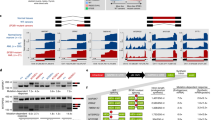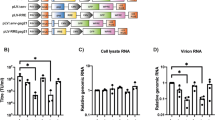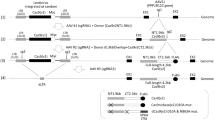Abstract
Suicide gene therapy is one of the most innovative approaches in which a potential toxic gene is delivered to the targeted cancer cell by different target delivery methods. We constructed a transfer vector to express green fluorescent protein (GFP) in transduced cells but not in packaging cells. We placed gfp under the control of the cytomegalovirus (CMV) promoter, which is positioned between the two long-terminal repeats in reverse direction. The intron-2 sequence of the human beta globin gene with two poly-A signals and several stop codons on the antisense strand was placed on the leading strand between the CMV promoter and gfp. For lentiviral production, the HEK293T and line were co-transfected with the PMD2G, psPAX2 and pLentiGFP-Ins2 plasmids. The HEK293T and line were transduced with this virus. PCR was performed for evaluation of intron splicing in transduced cells. The GFP expression was seen in 65% of the cells transduced. The PCR amplification of the genomic DNA of transduced cells confirmed the splicing of intron 2. The strategy is significant to accomplish our goal for preserving the packaging cells from the toxic gene expression during viral assembly and the resultant reduction in viral titration. Also it serves to address several other issues in the gene therapy.
This is a preview of subscription content, access via your institution
Access options
Subscribe to this journal
Receive 12 print issues and online access
$259.00 per year
only $21.58 per issue
Buy this article
- Purchase on Springer Link
- Instant access to full article PDF
Prices may be subject to local taxes which are calculated during checkout





Similar content being viewed by others
References
Ginn SL, Alexander IE, Edelstein ML, Abedi MR, Wixon J . Gene therapy clinical trials worldwide to 2012—an update. J Gene Med 2013; 15: 65–77.
Malecki M . Frontiers in suicide gene therapy of cancer. J Genet Syndr Gene Ther 2012; 2012: e114.
Razi Soofiyani S, Baradaran B, Lotfipour F, Kazemi T, Mohammadnejad L . Gene therapy, early promises, subsequent problems, and recent breakthroughs. Adv Pharm Bull 2013; 3: 249–255.
Vile RG, Russell SJ, Lemoine NR . Cancer gene therapy: hard lessons and new courses. Gene Ther 2000; 7: 2–8.
Springer CJ, Niculescu-Duvaz I . Prodrug-activating systems in suicide gene therapy. J Clin Invest 2000; 105: 1161–1167.
Yang WS, Park SO, Yoon AR, Yoo JY, Kim MK, Yun CO et al. Suicide cancer gene therapy using pore-forming toxin, streptolysin O. Mol Cancer Ther 2006; 5: 1610–1619.
Chen H . Exploiting the intron-splicing mechanism of insect cells to produce viral vectors harboring toxic genes for suicide gene therapy. Mol Ther Nucleic Acids 2012; 1: e57.
Massuda ES, Dunphy EJ, Redman RA, Schreiber JJ, Nauta LE, Barr FG et al. Regulated expression of the diphtheria toxin A chain by a tumor-specific chimeric transcription factor results in selective toxicity for alveolar rhabdomyosarcoma cells. Proc Natl Acad Sci USA 1997; 94: 14701–14706.
Keyvani K, Baur I, Paulus W . Tetracycline-controlled expression but not toxicity of an attenuated diphtheria toxin mutant. Life Sci 1999; 64: 1719–1724.
Kurayoshi K, Ozono E, Iwanaga R, Bradford AP, Komori H, Ohtani K . Cancer cell specific cytotoxic gene expression mediated by ARF tumor suppressor promoter constructs. Biochem Biophys Res Commun 2014; 450: 240–246.
Wang CY, Li F, Yang Y, Guo HY, Wu CX, Wang S . Recombinant baculovirus containing the diphtheria toxin A gene for malignant glioma therapy. Cancer Res 2006; 66: 5798–5806.
Li Y, McCadden J, Ferrer F, Kruszewski M, Carducci M, Simons J et al. Prostate-specific expression of the diphtheria toxin A chain (DT-A): studies of inducibility and specificity of expression of prostate-specific antigen promoter-driven DT-A adenoviral-mediated gene transfer. Cancer Res 2002; 62: 2576–2582.
Kohlschutter J, Michelfelder S, Trepel M . Novel cytotoxic vectors based on adeno-associated virus. Toxins (Basel) 2010; 2: 2754–2768.
Keyvani K, Baur I, Paulus W . Tetracycline-controlled expression but not toxicity of an attenuated diphtheria toxin mutant. Life Sci 1999; 64: 1719–1724.
McCormick F . Cancer gene therapy: fringe or cutting edge? Nat Rev Cancer 2001; 1: 130–141.
McTaggart S, Al-Rubeai M . Retroviral vectors for human gene delivery. Biotechnol Adv 2002; 20: 1–31.
Santhosh CV, Tamhane MC, Kamat RH, Patel VV, Mukhopadhyaya R . A lentiviral vector with novel multiple cloning sites: stable transgene expression in vitro and in vivo. Biochem Biophys Res Commun 2008; 371: 546–550.
Mohammadi Z, Shariati L, Khanahmad H, Kolahdouz M, Kianpoor F, Ghanbari JA et al. A lentiviral vector expressing desired gene only in transduced cells: an approach for suicide gene therapy. Mol Biotechnol 2015; 57: 793–800.
Chen KG, Valencia JC, Gillet JP, Hearing VJ, Gottesman MM . Involvement of ABC transporters in melanogenesis and the development of multidrug resistance of melanoma. Pigment Cell Melanoma Res 2009; 22: 740–749.
Denning C, Pitts JD . Bystander effects of different enzyme-prodrug systems for cancer gene therapy depend on different pathways for intercellular transfer of toxic metabolites, a factor that will govern clinical choice of appropriate regimes. Hum Gene Ther 1997; 8: 1825–1835.
Sakuma T, Barry MA, Ikeda Y . Lentiviral vectors: basic to translational. Biochem J 2012; 443: 603–618.
Plumb JA, Bilsland A, Kakani R, Zhao J, Glasspool RM, Knox RJ et al. Telomerase-specific suicide gene therapy vectors expressing bacterial nitroreductase sensitize human cancer cells to the pro-drug CB1954. Oncogene 2001; 20: 7797–7803.
Yamaizumi M, Mekada E, Uchida T, Okada Y . One molecule of diphtheria toxin fragment A introduced into a cell can kill the cell. Cell 1978; 15: 245–250.
Qu X, Wang P, Ding D, Li L, Wang H, Ma L et al. Zinc-finger-nucleases mediate specific and efficient excision of HIV-1 proviral DNA from infected and latently infected human T cells. Nucleic Acids Res 2013; 41: 7771–7782.
Cox DB, Platt RJ, Zhang F . Therapeutic genome editing: prospects and challenges. Nat Med 2015; 21: 121–131.
Manjunath N, Yi G, Dang Y, Shankar P . Newer gene editing technologies toward HIV gene therapy. Viruses 2013; 5: 2748–2766.
Acknowledgements
We are deeply grateful to Isfahan University of Medical Sciences deputy of research due to their support (Grant No. 393441). We thank Dr Reza Yousefi for the critical review of this manuscript. This work was supported by a grant (No. 393441) from the Isfahan University of Medical Sciences.
Author information
Authors and Affiliations
Corresponding author
Ethics declarations
Competing interests
The authors declare no conflict of interest.
Rights and permissions
About this article
Cite this article
Pourzadegan, F., Shariati, L., Taghizadeh, R. et al. Using intron splicing trick for preferential gene expression in transduced cells: an approach for suicide gene therapy. Cancer Gene Ther 23, 7–12 (2016). https://doi.org/10.1038/cgt.2015.57
Received:
Revised:
Accepted:
Published:
Issue Date:
DOI: https://doi.org/10.1038/cgt.2015.57
This article is cited by
-
Combination of MPPa-PDT and HSV1-TK/GCV gene therapy on prostate cancer
Lasers in Medical Science (2018)



